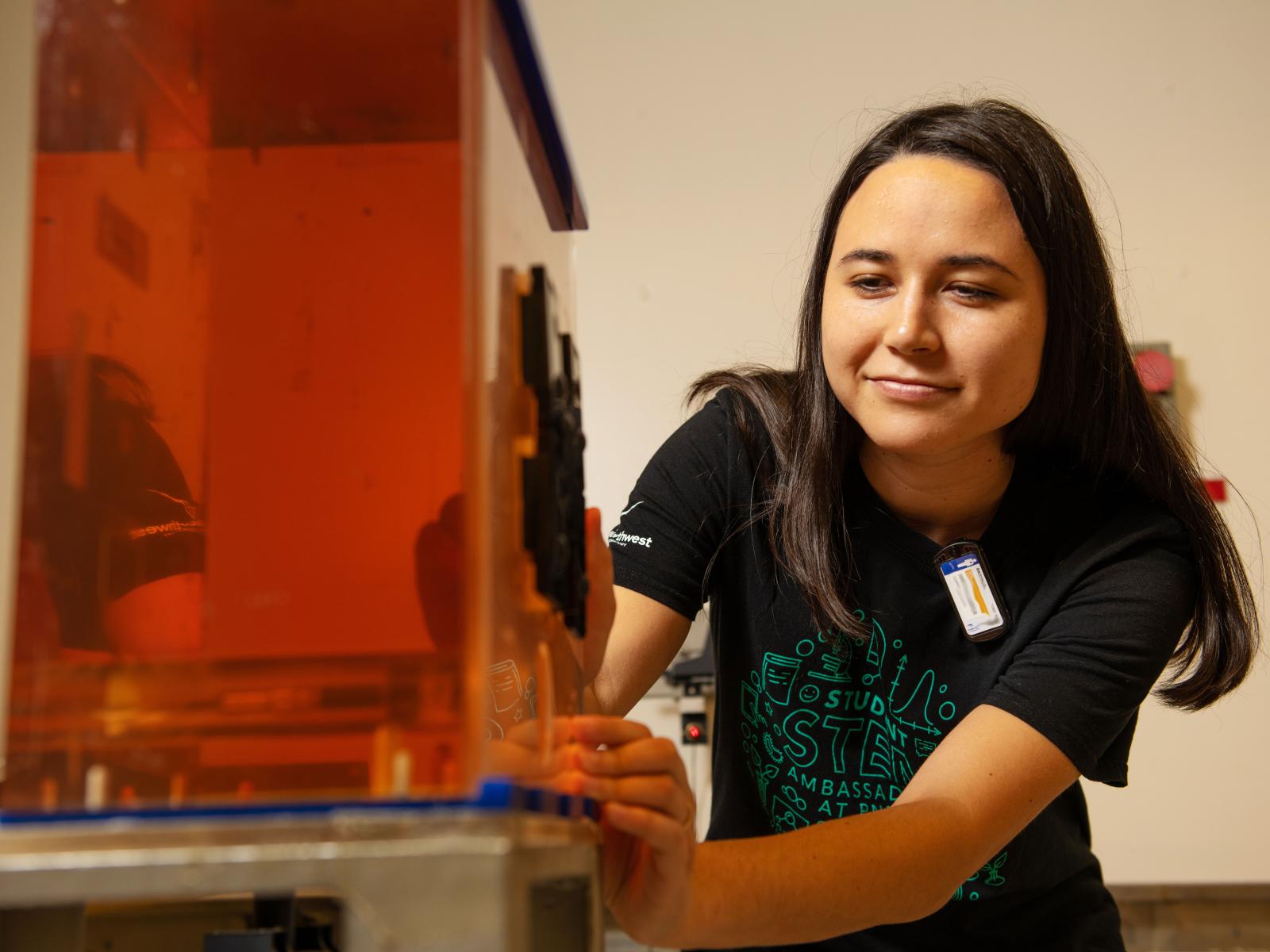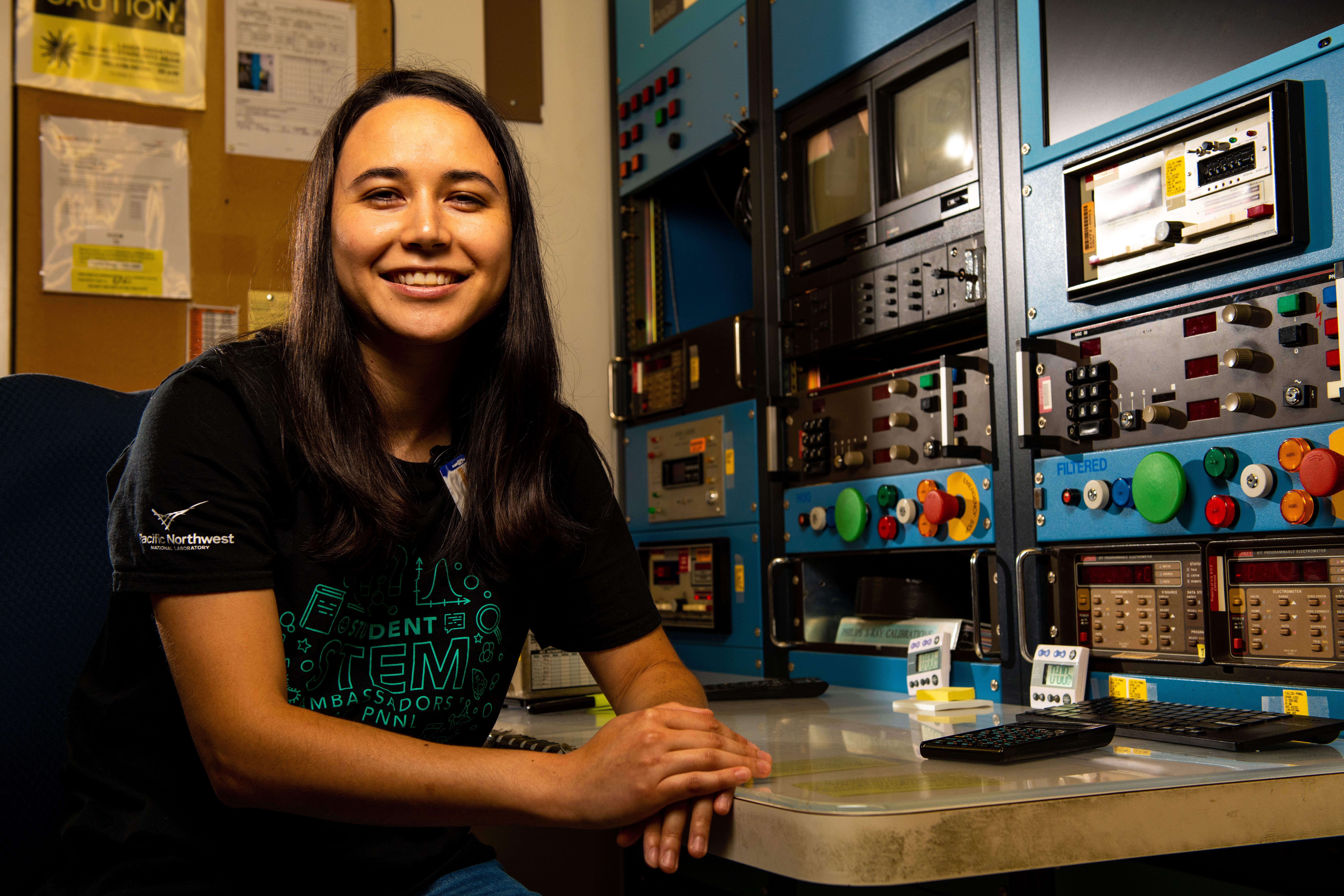PNNL Interns' Research Runs the Scientific Gamut

Intern Jennifer Meza is learning how to use health physics instrumentation and training to be a radiological technician.
(Photo by Andrea Starr | Pacific Northwest National Laboratory)
Adria Peterkin’s summer reading list is a lot different than most of ours. As an intern with the Department of Energy’s Pacific Northwest National Laboratory, she’s researching what materials might be best suited to capturing particles from an explosion so they can be studied to understand the nature of the blast.
Between finishing her master’s degree at the University of California, Berkeley, and beginning her Ph.D. at the Massachusetts Institute of Technology, Adria joined this year’s nearly 1,200 interns and research associates who contribute to PNNL’s research efforts while honing their technical skills and gaining valuable experience.
PNNL’s internships align with our commitment to science, technology, engineering and mathematics (STEM) education. They help prepare the next generation of scientific leaders and allow them to work on real science and technology projects.
For Adria, that means supporting a project aiming to reconstruct an explosion—similar to the way detectives reconstruct a crime scene—by conducting forensic analyses of ballistic particles as small as one micron in diameter. The challenge is finding a material to catch these tiny particles without damaging them so the effects of the blast can be studied with a special microscope.
Her research—done virtually from her family’s home in Atlanta—has helped identify potential so-called “soft-catch” materials that can accommodate the techniques researchers will use to study the particles. For example, the materials must be non-flammable so researchers can take different approaches to look for meaningful clues about the explosion’s source material, shock profile and detonation velocity.
Meanwhile, Alex Izquierdo is at our Marine and Coastal Research Laboratory in Sequim, Wash., conducting experiments to understand how oxygen levels in sediment are affected by different biological and chemical processes. Ultimately, his research could help determine which habitats are best for various plants and animals in a stream’s ecosystem and the stability of carbon stored in coastal habitats.
Alex, a Hanford High School graduate, just earned his bachelor’s degree in environmental science from the University of Washington. His project involves sediment samples from a tidal creek and coastal forest in Washington. The sample depths ranged from sea level to several meters above and were taken along the path to the ocean to capture increases in salinity as fresh and saltwater begin to mix.
Using an approach that he developed, Alex begins by dividing each sample into two vials. He heats one to eliminate any living organisms, isolating the chemical processes. The other vial remains untreated, so both the biological and chemical processes remain. The dissolved oxygen levels of each vial are measured in 30-second intervals over a 24-hour period, revealing insights into the roles of minerals, nutrients and microorganisms in the sediment.
Another intern, Jennifer Meza, started her internship after going back to school at Columbia Basin College to pursue a two-year degree in instrumentation and controls. Jen is working in our accredited radiological calibration lab to test and calibrate the dosimeters worn by personnel in hospitals, nuclear facilities and other environments where monitoring potential exposure to radiation is important to protecting their health.

Jen safely irradiates the dosimeters from these facilities with known doses of gamma, beta or neutron radiation. The dosimeters are then returned so providers can analyze them and report the recorded dose to PNNL, where Jen’s team determines whether they are measuring the dosage with the accuracy required by national standards.
Jen is also learning how to use health physics instrumentation and training to be a radiological technician—a nice fit with her plans to continue at CBC to earn a bachelor’s degree in health physics.
Every year, we are inspired by intelligent, enthusiastic interns like Adria, Alex and Jen. They give us hope, knowing these problem-solvers of tomorrow will help make the world a better place. And perhaps a few will do so as future colleagues at PNNL.
Steven Ashby, director of Pacific Northwest National Laboratory, writes this column monthly. To read previous Director's Columns, please visit our Director's Column Archive.
Published: August 23, 2021